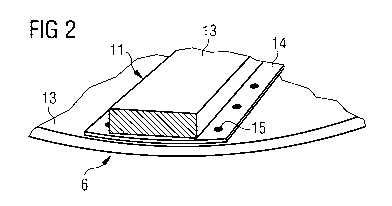Some of the information on this Web page has been provided by external sources. The Government of Canada is not responsible for the accuracy, reliability or currency of the information supplied by external sources. Users wishing to rely upon this information should consult directly with the source of the information. Content provided by external sources is not subject to official languages, privacy and accessibility requirements.
Any discrepancies in the text and image of the Claims and Abstract are due to differing posting times. Text of the Claims and Abstract are posted:
| (12) Patent Application: | (11) CA 2789825 |
|---|---|
| (54) English Title: | METHOD FOR ASSEMBLING PART OF A GENERATOR, GENERATOR AND WIND TURBINE |
| (54) French Title: | PROCEDE D'ASSEMBLAGE D'UNE PARTIE D'UN GENERATEUR, GENERATEUR ET TURBINE D'EOLIENNE |
| Status: | Deemed Abandoned and Beyond the Period of Reinstatement - Pending Response to Notice of Disregarded Communication |
| (51) International Patent Classification (IPC): |
|
|---|---|
| (72) Inventors : |
|
| (73) Owners : |
|
| (71) Applicants : |
|
| (74) Agent: | SMART & BIGGAR LP |
| (74) Associate agent: | |
| (45) Issued: | |
| (86) PCT Filing Date: | 2010-02-16 |
| (87) Open to Public Inspection: | 2011-08-25 |
| Examination requested: | 2014-10-07 |
| Availability of licence: | N/A |
| Dedicated to the Public: | N/A |
| (25) Language of filing: | English |
| Patent Cooperation Treaty (PCT): | Yes |
|---|---|
| (86) PCT Filing Number: | PCT/EP2010/000961 |
| (87) International Publication Number: | WO 2011100987 |
| (85) National Entry: | 2012-08-14 |
| (30) Application Priority Data: | None |
|---|
A method for assembling part of a generator (6) is provided, wherein a magnet assembly (11) comprising at least one magnet (13) and a mounting plate (14) is fastened to a base element (12) by welding (15) the mounting plate (14) to the base element (12).
L'invention concerne un procédé d'assemblage d'une partie d'un générateur (6). Selon l'invention, un système (11) d'aimant comprenant au moins un aimant (13) et une plaque de montage (14) est attaché à un élément de base (12) par soudage (15) de la plaque de montage (14) à l'élément de base (12).
Note: Claims are shown in the official language in which they were submitted.
Note: Descriptions are shown in the official language in which they were submitted.

2024-08-01:As part of the Next Generation Patents (NGP) transition, the Canadian Patents Database (CPD) now contains a more detailed Event History, which replicates the Event Log of our new back-office solution.
Please note that "Inactive:" events refers to events no longer in use in our new back-office solution.
For a clearer understanding of the status of the application/patent presented on this page, the site Disclaimer , as well as the definitions for Patent , Event History , Maintenance Fee and Payment History should be consulted.
| Description | Date |
|---|---|
| Inactive: IPC expired | 2022-01-01 |
| Application Not Reinstated by Deadline | 2017-07-04 |
| Inactive: Dead - No reply to s.30(2) Rules requisition | 2017-07-04 |
| Deemed Abandoned - Failure to Respond to Maintenance Fee Notice | 2017-02-16 |
| Inactive: Abandoned - No reply to s.30(2) Rules requisition | 2016-07-04 |
| Inactive: S.30(2) Rules - Examiner requisition | 2016-01-04 |
| Inactive: Report - No QC | 2015-12-17 |
| Change of Address or Method of Correspondence Request Received | 2015-01-15 |
| Letter Sent | 2014-10-17 |
| Request for Examination Requirements Determined Compliant | 2014-10-07 |
| Request for Examination Received | 2014-10-07 |
| All Requirements for Examination Determined Compliant | 2014-10-07 |
| Inactive: Cover page published | 2012-10-25 |
| Application Received - PCT | 2012-09-28 |
| Inactive: Notice - National entry - No RFE | 2012-09-28 |
| Inactive: IPC assigned | 2012-09-28 |
| Inactive: IPC assigned | 2012-09-28 |
| Inactive: First IPC assigned | 2012-09-28 |
| National Entry Requirements Determined Compliant | 2012-08-14 |
| Application Published (Open to Public Inspection) | 2011-08-25 |
| Abandonment Date | Reason | Reinstatement Date |
|---|---|---|
| 2017-02-16 |
The last payment was received on 2016-01-13
Note : If the full payment has not been received on or before the date indicated, a further fee may be required which may be one of the following
Please refer to the CIPO Patent Fees web page to see all current fee amounts.
| Fee Type | Anniversary Year | Due Date | Paid Date |
|---|---|---|---|
| Basic national fee - standard | 2012-08-14 | ||
| MF (application, 2nd anniv.) - standard | 02 | 2012-02-16 | 2012-08-14 |
| MF (application, 3rd anniv.) - standard | 03 | 2013-02-18 | 2013-01-17 |
| MF (application, 4th anniv.) - standard | 04 | 2014-02-17 | 2014-01-14 |
| Request for examination - standard | 2014-10-07 | ||
| MF (application, 5th anniv.) - standard | 05 | 2015-02-16 | 2015-01-22 |
| MF (application, 6th anniv.) - standard | 06 | 2016-02-16 | 2016-01-13 |
Note: Records showing the ownership history in alphabetical order.
| Current Owners on Record |
|---|
| SIEMENS AKTIENGESELLSCHAFT |
| Past Owners on Record |
|---|
| KURT ANDERSEN |